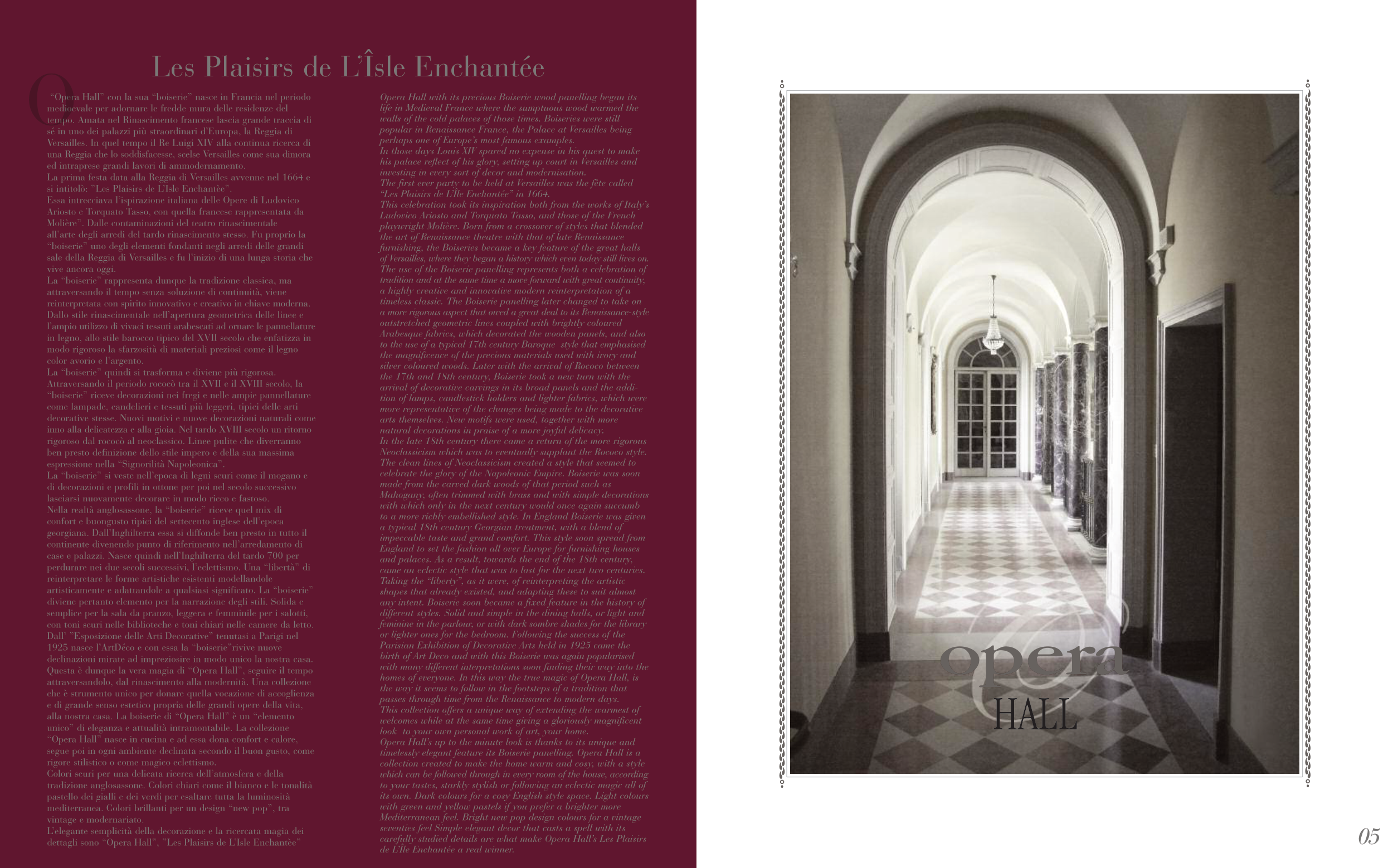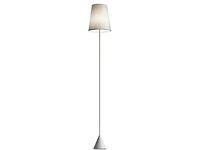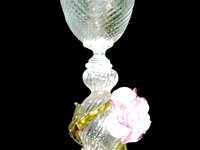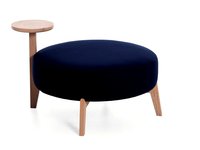05
“Opera Hall” con la sua “boiserie” nasce in Francia nel periodo
medioevale per adornare le fredde mura delle residenze del
tempo. Amata nel Rinascimento francese lascia grande traccia di
sé in uno dei palazzi più straordinari d’Europa, la Reggia di
Versailles. In quel tempo il Re Luigi XIV alla continua ricerca di
una Reggia che lo soddisfacesse, scelse Versailles come sua dimora
ed intraprese grandi lavori di ammodernamento.
La prima festa data alla Reggia di Versailles avvenne nel 1664 e
si intitolò: ”Les Plaisirs de L’Isle Enchantèe”.
Essa intrecciava l’ispirazione italiana delle Opere di Ludovico
Ariosto e Torquato Tasso, con quella francese rappresentata da
Molière”. Dalle contaminazioni del teatro rinascimentale
all’arte degli arredi del tardo rinascimento stesso. Fu proprio la
“boiserie” uno degli elementi fondanti negli arredi delle grandi
sale della Reggia di Versailles e fu l’inizio di una lunga storia che
vive ancora oggi.
La “boiserie” rappresenta dunque la tradizione classica, ma
attraversando il tempo senza soluzione di continuità, viene
reinterpretata con spirito innovativo e creativo in chiave moderna.
Dallo stile rinascimentale nell’apertura geometrica delle linee e
l’ampio utilizzo di vivaci tessuti arabescati ad ornare le pannellature
in legno, allo stile barocco tipico del XVII secolo che enfatizza in
modo rigoroso la sfarzosità di materiali preziosi come il legno
color avorio e l’argento.
La “boiserie” quindi si trasforma e diviene più rigorosa.
Attraversando il periodo rococò tra il XVII e il XVIII secolo, la
“boiserie” riceve decorazioni nei fregi e nelle ampie pannellature
come lampade, candelieri e tessuti più leggeri, tipici delle arti
decorative stesse. Nuovi motivi e nuove decorazioni naturali come
inno alla delicatezza e alla gioia. Nel tardo XVIII secolo un ritorno
rigoroso dal rococò al neoclassico. Linee pulite che diverranno
ben presto definizione dello stile impero e della sua massima
espressione nella “Signorilità Napoleonica”.
La “boiserie” si veste nell’epoca di legni scuri come il mogano e
di decorazioni e profili in ottone per poi nel secolo successivo
lasciarsi nuovamente decorare in modo ricco e fastoso.
Nella realtà anglosassone, la “boiserie” riceve quel mix di
confort e buongusto tipici del settecento inglese dell’epoca
georgiana. Dall’Inghilterra essa si diffonde ben presto in tutto il
continente divenendo punto di riferimento nell’arredamento di
case e palazzi. Nasce quindi nell’Inghilterra del tardo 700 per
perdurare nei due secoli successivi, l’eclettismo. Una “libertà” di
reinterpretare le forme artistiche esistenti modellandole
artisticamente e adattandole a qualsiasi significato. La “boiserie”
diviene pertanto elemento per la narrazione degli stili. Solida e
semplice per la sala da pranzo, leggera e femminile per i salotti,
con toni scuri nelle biblioteche e toni chiari nelle camere da letto.
Dall’ ”Esposizione delle Arti Decorative” tenutasi a Parigi nel
1925 nasce l’ArtDéco e con essa la “boiserie”rivive nuove
declinazioni mirate ad impreziosire in modo unico la nostra casa.
Questa è dunque la vera magia di “Opera Hall”, seguire il tempo
attraversandolo, dal rinascimento alla modernità. Una collezione
che è strumento unico per donare quella vocazione di accoglienza
e di grande senso estetico propria delle grandi opere della vita,
alla nostra casa. La boiserie di “Opera Hall” è un “elemento
unico” di eleganza e attualità intramontabile. La collezione
“Opera Hall” nasce in cucina e ad essa dona confort e calore,
segue poi in ogni ambiente declinata secondo il buon gusto, come
rigore stilistico o come magico eclettismo.
Colori scuri per una delicata ricerca dell’atmosfera e della
tradizione anglosassone. Colori chiari come il bianco e le tonalità
pastello dei gialli e dei verdi per esaltare tutta la luminosità
mediterranea. Colori brillanti per un design “new pop”, tra
vintage e modernariato.
L’elegante semplicità della decorazione e la ricercata magia dei
dettagli sono “Opera Hall”, ”Les Plaisirs de L’Isle Enchantèe”
Opera Hall with its precious Boiserie wood panelling began its
life in Medieval France where the sumptuous wood warmed the
walls of the cold palaces of those times. Boiseries were still
popular in Renaissance France, the Palace at Versailles being
perhaps one of Europe’s most famous examples.
In those days Louis XIV spared no expense in his quest to make
his palace reflect of his glory, setting up court in Versailles and
investing in every sort of decor and modernisation.
The first ever party to be held at Versailles was the fête called
“Les Plaisirs de L’Île Enchantée” in 1664.
This celebration took its inspiration both from the works of Italy’s
Ludovico Ariosto and Torquato Tasso, and those of the French
playwright Molière. Born from a crossover of styles that blended
the art of Renaissance theatre with that of late Renaissance
furnishing, the Boiseries became a key feature of the great halls
of Versailles, where they began a history which even today still lives on.
The use of the Boiserie panelling represents both a celebration of
tradition and at the same time a move forward with great continuity,
a highly creative and innovative modern reinterpretation of a
timeless classic. The Boiserie panelling later changed to take on
a more rigorous aspect that owed a great deal to its Renaissance-style
outstretched geometric lines coupled with brightly coloured
Arabesque fabrics, which decorated the wooden panels, and also
to the use of a typical 17th century Baroque style that emphasised
the magnificence of the precious materials used with ivory and
silver coloured woods. Later with the arrival of Rococo between
the 17th and 18th century, Boiserie took a new turn with the
arrival of decorative carvings in its broad panels and the addi-
tion of lamps, candlestick holders and lighter fabrics, which were
more representative of the changes being made to the decorative
arts themselves. New motifs were used, together with more
natural decorations in praise of a more joyful delicacy.
In the late 18th century there came a return of the more rigorous
Neoclassicism which was to eventually supplant the Rococo style.
The clean lines of Neoclassicism created a style that seemed to
celebrate the glory of the Napoleonic Empire. Boiserie was soon
made from the carved dark woods of that period such as
Mahogany, often trimmed with brass and with simple decorations
with which only in the next century would once again succumb
to a more richly embellished style. In England Boiserie was given
a typical 18th century Georgian treatment, with a blend of
impeccable taste and grand comfort. This style soon spread from
England to set the fashion all over Europe for furnishing houses
and palaces. As a result, towards the end of the 18th century,
came an eclectic style that was to last for the next two centuries.
Taking the “liberty”, as it were, of reinterpreting the artistic
shapes that already existed, and adapting these to suit almost
any intent. Boiserie soon became a fixed feature in the history of
different styles. Solid and simple in the dining halls, or light and
feminine in the parlour, or with dark sombre shades for the library
or lighter ones for the bedroom. Following the success of the
Parisian Exhibition of Decorative Arts held in 1925 came the
birth of Art Deco and with this Boiserie was again popularised
with many different interpretations soon finding their way into the
homes of everyone. In this way the true magic of Opera Hall, is
the way it seems to follow in the footsteps of a tradition that
passes through time from the Renaissance to modern days.
This collection offers a unique way of extending the warmest of
welcomes while at the same time giving a gloriously magnificent
look to your own personal work of art, your home.
Opera Hall’s up to the minute look is thanks to its unique and
timelessly elegant feature its Boiserie panelling. Opera Hall is a
collection created to make the home warm and cosy, with a style
which can be followed through in every room of the house, according
to your tastes, starkly stylish or following an eclectic magic all of
its own. Dark colours for a cosy English style space. Light colours
with green and yellow pastels if you prefer a brighter more
Mediterranean feel. Bright new pop design colours for a vintage
seventies feel Simple elegant decor that casts a spell with its
carefully studied details are what make Opera Hall’s Les Plaisirs
de L’Île Enchantée a real winner.
Les Plaisirs de L’Îsle Enchantée
HALL










































